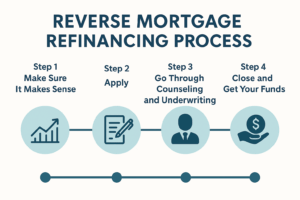
By Tyler Plack
Tyler Plack is the President of South River Mortgage. Tyler holds an active FHA Direct Endorsement (DE) underwriting certification and is the author of The Retirement Solution: Maximizing Your BenefitTyler is a seasoned entrepreneur and real estate investor renowned for his expertise in reverse mortgages and his commitment to addressing seniors' equity challenges. Tyler brings a unique perspective to his ventures, having built several successful companies throughout his career. His insights are frequently sought by industry publications, where he is recognized for his vast knowledge in the realm of reverse mortgages.
An avid investor in income-producing properties, Tyler is dedicated to helping seniors navigate their financial needs with compassion and expertise. When Tyler is not helping solve America's retirement crisis, he is a skilled pilot flying airplanes for fun.
For many seniors, a reverse mortgage is a helpful tool to unlock home equity and provide a steady income stream during retirement. But what happens when circumstances change? Can you refinance a reverse mortgage?
In this detailed guide, we’ll explore the reverse mortgage refinancing process, explain the eligibility requirements, and discuss the benefits and risks of refinancing. Whether you want to lower your loan balance, access more equity, or change the terms of your reverse mortgage, we’ve got all the information you need to make an informed decision.

What Is a Reverse Mortgage?
Before diving into the specifics of refinancing, let’s briefly review what a reverse mortgage is. A reverse mortgage allows homeowners aged 62 or older to access the equity in their homes without making monthly mortgage payments. Instead, the lender makes payments to the homeowner, and the loan is repaid when the homeowner sells the home, moves out, or passes away.
The most common type of reverse mortgage is the Home Equity Conversion Mortgage (HECM), which is insured by the Federal Housing Administration (FHA). There are also jumbo reverse mortgages for homes that exceed the FHA limits.
Can You Refinance a Reverse Mortgage?
Yes, you can refinance a reverse mortgage, but there are specific requirements and considerations you need to be aware of. Refinancing a reverse mortgage is similar to refinancing a traditional mortgage, but there are some key differences due to the unique nature of reverse mortgages.
You might consider refinancing a reverse mortgage for several reasons:
- Access More Equity: If your home has appreciated in value since your initial reverse mortgage was taken out, you might be able to access more equity by refinancing.
- Lower Interest Rates: If interest rates have dropped since you took out your reverse mortgage, refinancing could allow you to secure a lower rate, which may lower your loan balance over time.
- Change Loan Terms: You might want to adjust the payment structure, for example, switching from a lump sum to monthly payments or a line of credit.
- Lower Fees: Refinancing might help you reduce fees or get better loan terms than before.
However, refinancing may not be the right option for everyone. Let’s take a look at the process and requirements.
How Does Refinancing a Reverse Mortgage Work?
The process for refinancing a reverse mortgage is straightforward but requires several key steps. First, you must meet the same eligibility requirements as the original reverse mortgage. You must be 62 years or older, your home must be your primary residence, and you need sufficient equity in the home.
Next, you’ll need an appraisal to determine your home’s current value, and the lender will review your financial situation. Like the original loan, refinancing comes with fees such as closing costs and an appraisal fee, which can be rolled into the new loan balance.
When you refinance a reverse mortgage, the lender will establish new loan terms based on your home’s current value and your financial situation. This could mean a higher loan balance or more cash available to you, depending on the terms.

Are You Eligible for a Reverse Mortgage?
(Find out in 60 seconds)
Benefits of Refinancing a Reverse Mortgage
Refinancing a reverse mortgage can offer several advantages, especially if your home’s value has increased or interest rates have dropped. If your home has appreciated in value, refinancing can allow you to access more equity, which can be used for a variety of financial needs, including healthcare or home improvements.
Another benefit of refinancing is the opportunity to secure a lower interest rate. If rates have dropped since you first took out your reverse mortgage, refinancing may allow you to lock in a better rate—potentially reducing your overall loan balance over time.
Refinancing can also offer greater flexibility in how you receive your funds, such as switching from a lump sum to monthly payments or a line of credit. In some cases, it may even support your plans for relocation or downsizing.
Potential Risks and Considerations of Refinancing
While refinancing can be beneficial, there are some risks and considerations to keep in mind. Refinancing can often result in a higher loan balance, as any closing costs or fees associated with refinancing are usually rolled into the loan. This means that while you may access more cash or lower your monthly payments, your loan balance could increase over time.
Additionally, refinancing typically comes with higher fees, including appraisal and closing costs. These costs can add up, and it’s important to weigh them against the benefits of refinancing to ensure it makes financial sense. Another consideration is the possibility of paying more interest over the life of the loan. Extending the loan term or withdrawing more equity could result in more interest being paid.
The Refinancing Process: Step-by-Step
Refinancing a reverse mortgage involves several steps:
1. Assess Your Financial Situation: Before refinancing, make sure you understand your financial needs and goals.
2. Find a Lender: Not all lenders offer reverse mortgage refinancing. It’s important to find one that specializes in reverse mortgage products.
3. Appraisal: Your lender will schedule an appraisal to determine your home’s current market value.
4. Review Terms and Fees: Make sure to review the new loan terms and associated fees. These could include new closing costs, administrative fees, and possibly higher loan balances.
5. Close the Loan: If you decide to proceed with refinancing, you’ll go through the closing process, which includes paying any fees and signing the new loan documents.

Talk to a Reverse Mortgage Specialist
If you’re considering refinancing your reverse mortgage, it’s important to speak with an experienced reverse mortgage advisor. At South River Mortgage, our team specializes in helping seniors explore their options and make the best decisions for their financial future. We’ll guide you through the refinancing process, answer your questions, and help you understand your loan options.
📞 Speak with a reverse mortgage specialist today to explore your refinancing options and get personalized advice.


